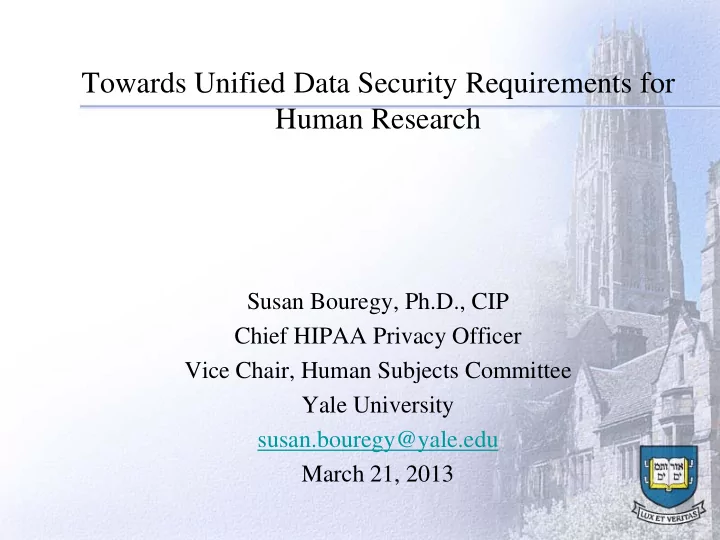

Towards Unified Data Security Requirements for Human Research Susan Bouregy, Ph.D., CIP Chief HIPAA Privacy Officer Vice Chair, Human Subjects Committee Yale University susan.bouregy@yale.edu March 21, 2013
Social Science, Behavioral and Educational Research at Yale • Approximately 600 active protocols • Broad range of studies – Cognitive development in children – The role of faith for individuals in conflict zones – Randomized trials of economic interventions in developing countries – Video ethnographies of marginalized communities
Yale as a HIPAA Covered Entity • Hybrid Entity – Faculty practice, health care clinic, self-insured health plan – 20,000 faculty, staff, students, etc are required to comply • Research conducted by faculty, staff and students in the covered entity are required to comply. • Research conducted by faculty, staff and students outside the covered entity only deal with HIPAA when attempting to access health information from a covered entity. • Most SBE projects are conducted outside the HIPAA covered entity.
Section V. Strengthening Data Protections to Minimize Informational Risks • Harmonizing concept of individually identifiable • Require data security protections indexed to identifiability • Use HIPAA security and breach notification standards as model for protection scheme
Informational Risk • What could happen if participant’s spouse, parent, boss, friends, police department, found out what he/she said? • Potential for deductive disclosure • Context dependent • Population dependent
Proposed Changes • Adopt the HIPAA standards for purposes of the Common Rule regarding what constitutes individually identifiable information, a limited data set, de- identified information.
Definitions • HIPAA: individually identifiable health information: identifies the individual or with respect to which there is a reasonable basis to believe the information can be used to identify the individual • CR: individually identifiable private information: the identity of the subject is or may readily be ascertained by the investigator or associated with the information
De-identification • HIPAA: – Strip 18 defined identifiers – Statistical determination of very small risk of re- identification • CR: – Undefined
Impacted Data Sets • Household surveys or ethnographic interviews that include zip codes of the respondents • Cognitive development data including dates of birth • Epidemiological data set including date of vaccination • Linguistic studies of endangered languages with limited numbers of speakers identified by country • Data security requirements would apply • Could not be deemed exempt
Issues • No single accepted term in the literature • Currently confusion on the part of IRBs and investigators regarding de-identified vs anonymous • More information would be considered identifiable under HIPAA definition • Focus on “individually identifiable” ignores community risks
Proposed Changes • Mandate data security and information protection standards that would apply to all research that collected, stored, analyzed or otherwise reused identifiable or potentially identifiable information. • Data security and information protection standards would be scaled appropriately to the level of identifiability of the data.
Key HIPAA Security Elements • Encryption of data at rest (laptops, desktops, thumbdrives, smart phones etc.) – Export control issues in some locations • Secure transmission of data (email encryption, secure file transfer) – Not user friendly • Strong physical security – Can be practical issues in remote field locations • Access controls and logging – Cloud storage issues
Issues • Suitability of IRB for determinations of appropriate data security plan • Proposed rule applies standards to all data including that from “excused” research and would apply to all institutions that have some federal funding • Not all identified data is risky • Not all studies promise confidentiality • Some participants request attribution • Costly
Identifiability vs. Sensitivity • Identified interviews with current or former combatants regarding actions in local communities • Identified data on participation in local elections in the US • Identified data on participation in elections in emerging democracies
Recommend Guidance for IRBs and PIs • IRB best suited for determining risk of harm • PI best suited for determining what is manageable in the field. • Provide guidance on solutions for low, medium and high risk data
Proposed Incorporation of HIPAA Breach Notification Requirement • Breach: the acquisition, access, use, or disclosure of PHI in a manner not permitted under subpart E of this part which compromises the security or privacy of the PHI • Presumed to be a breach unless the covered entity demonstrates that there is a low probability that the protected health information has been compromised based on a risk assessment
IRB Adverse Event and Unanticipated Problem Reporting • Data breaches qualify as AE/UAPIRSO • Consideration of notice to participants as part of risk mitigation strategy • Common considerations: – Extent of possible harm – Ability to further mitigate harm based on awareness – Autonomy considerations
Issues • HIPAA breach standards are more stringent, require reporting more incidents • Costs of investigation and notice • Incident fatigue • Utility of providing awareness of events for which there is no preventative action that can be taken • Utility of providing information transnationally when the risk is local/contextual • Providing notice in studies conducted under a waiver of consent • Harm arising from notice itself based on association with the study.
Conclusions • Applaud an effort to harmonize terminology around identifiability of data • Applaud an effort to provide a mechanism for IRBs to minimize informational risks • Informational risks are not sufficiently correlated to identifiability alone to allow indexing data security needs to presence of identifiers • The costs of data security and breach notification requirements must be justified by the anticipated risks to the data and benefit of the notice • The diversity of SBE research requires that the risk mitigation strategy be flexible
Recommend
More recommend